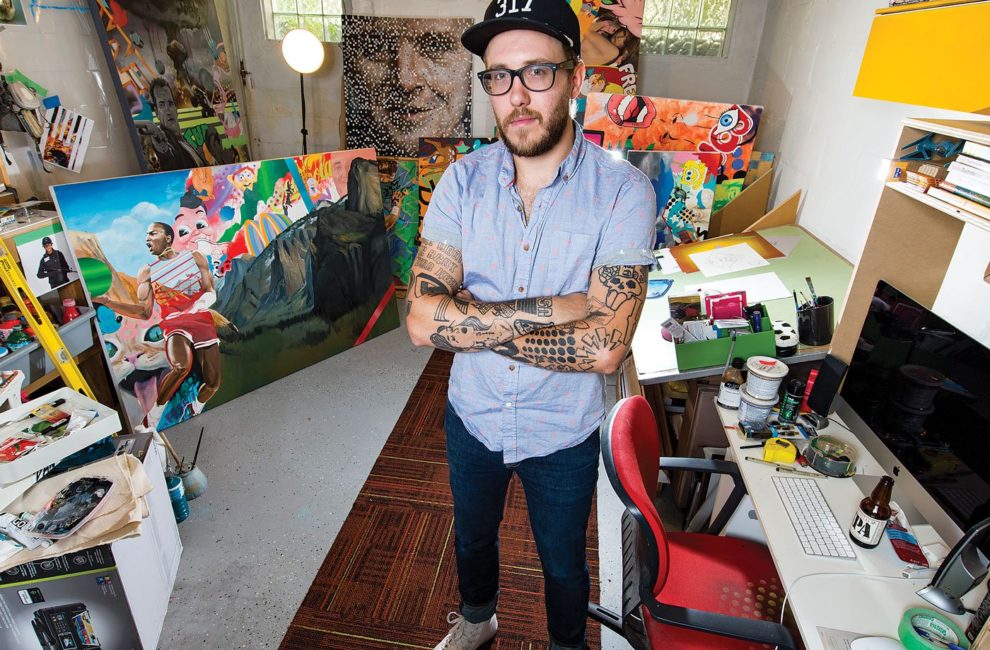
Ask Me Anything: Martin Kuntz
Colts fans might be familiar with Ryan Feeney, the sculptor of the Peyton Manning statue that will be unveiled outside Lucas Oil Stadium this weekend. While Feeney was the Peyton Manning of the Manning project, the 31-year-old Kuntz, a large-scale Pop painter originally from the Netherlands, played a key role, too.
INTERVIEW BY SARAH BAHR
What was your role on the project?
I created a 3-D model of the bronze and then ran it on our CNC, which is basically a giant 3-D printer. I assembled everything, welded a steel armature in the middle, and hand-carved the rest. I made the [initial model] 85 to 90 percent of the way, and then Feeney added clay for the details in the wrinkles, the hands, and the numbers on the jersey, and then he cast it in bronze. So it was definitely a collaborative effort.
Are you a Manning guy?
I’ve been a pretty big Colts fan since I was a kid. I have a Colts tattoo on my chest, and I went to college in Baltimore, which is the worst place to ever be a Colts fan. I also took an icon painting class in college, and created a life-size iconography of Peyton Manning with a gold-leaf halo after he won the Super Bowl with Indianapolis.
You’ve done a lot of work around the city, from the murals at Tappers Arcade Bar to a hole you designed for this year’s mini golf course at the Indianapolis Museum of Art.
I did a hole at the IMA last year, and this year as well. Last year’s was Benjamin Harrison. It was pretty goofy—one of his hands was doing a peace sign, and if you got the ball in the secret spot, it would come out of his mouth and go towards the hole. This year’s hole was titled “The Carpet is Hot Lava,” and it was a triceratops being burned alive slash drowning in a pool of lava.
How’d you dream up that?
We had a prop in storage at my company, Creative Works, that I made four years ago that a client backed out on. It was unpainted, and the boss didn’t like it, so I knew that if I pitched that, it would at least save me a little bit of work. I’ve got a pretty morbid sense of humor.
Quite a different experience from having Manning model for the statue.
He put on the pads, and I just looked like a dumbfounded child staring at him. He went through the motions of throwing with the equipment manager, and for 20 minutes he pretended he was in a game, and we were just snapping pictures.
Where did this happen?
We flew on [Jim] Irsay’s plane and met Manning at an airport hangar in Nashville. It was very James Bond–like. We took off at 1 p.m., and I asked, “All right, should I be there at 11?” They were like, “No, just be here like 15 minutes early.” It’s not like a regular airport; you can just show up, and then they fly.
What’s the inside of the plane like?
It’s pretty swanky. The airline stewardess was like, “Even if you don’t have to go to the bathroom, you should go in there.” And I was like, “Okay.” And—I’m assuming they’re not real—but he had a [Super Bowl] ring on display in the bathroom.
What research did you do on Manning before you started sculpting?
We took photos of every single detail of his uniform, from the stitching and the shoes to the wrinkles on his hands, and we tried to get as much close-up detail of everything as we could. And then it was just a lot of looking at photos and watching videos of how he threw.
What’s he like in person?
All business. I was hoping that we would, you know, exchange numbers, and talk about fantasy football, and be best friends, but that did not happen.
Do you have a favorite memory from working on the statue?
I made a really bad joke that Peyton didn’t think was funny. We got to Nashville, and we went over why we needed to take all the photos, and what the process was going to be like, and towards the end he was like, “All right, I need to fly out of here in an hour, so let’s make it quick.” And so, being a football fan, I was like, “All right, everybody, sounds like we need to execute the two-minute drill.” And the Colts camera guy chuckled, but no one else. I thought it was hilarious, but apparently it fell terribly short.
What was the toughest part of this project?
I sculpt things all the time—dinosaurs, robots, and stuff like that—but none of those have the emotional attachment that something like this does. There was definitely a lot of pressure—I mean, it’s Peyton in Indianapolis, so you don’t want to mess it up.





